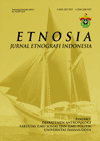Authenticity and creativity: The development of pencak silat in Sumedang
DOI:
https://doi.org/10.31947/etnosia.v5i1.9641Keywords:
Authenticity, creativity, pencak silat, Sumedang, West Java.Abstract
Many studies of silat have documented the jurus (moves) or aliran (streams) in silat, especially those based on tradition.Even so, there are still many things about this martial arts tradition that have not been deeply touched, for instance, how it can be developed without losing the authenticity of the tradition. We exercise it as a problem of how tradition and change should be defined, how authenticity is placed in a dynamic context, and how silat practitioners continue their creativity. Within an anthropological perspective, we put forward the case of the Perguruan Silat Garuda Putih in Sumedang to study how the individual ideas, learning process, and creations; and authenticity, structure, and power are tied together. The Sumedang silat tradition which originated from various aliran has been structured as a unique gaya (style) of fighting. The role of perguruan (silat training center), systematically keeps a beginner in silat to learn standard silat. At the end of learning, however, we believe that the process of creating moves and ibing (opening movements) shows a high dynamic amidst creativity, aligning movements with standards, maintaining authenticity, but at the same time also marking the individual characteristics of students.Downloads
References
Bourdieu, P. (1977). Outline of a Theory of Practice (Vol. 16). Cambridge University Press.
Bourdieu, P. (1983). The field of cultural production, or the economic world reversed. Poetics, 12(4-5), 311-356.
Bourdieu, P. (1990). The logic of practice. Stanford University Press.
de Grave, J.M. (2016). The Standardisation of Pencak Silat: Javanisation, Nationalism, and Internationalisation. The Fighting Art of Pencak Silat and its Music (pp. 45-75). Leiden, Brill.
Draeger, Donn F. 1972. The weapons and fighting arts of Indonesia. Vermont/Tokyo
Facal, G. (2016). Keyakinan dan kekuatan: Seni bela diri Silat Banten. Yayasan Pustaka Obor Indonesia.
Handler, R. (1986). Authenticity. Anthropology Today, 1(1), 2-4
Hanson, A. (1989). The making of the Maori: Culture invention and its logic. American Anthropologist, 91(4), 890-902
Hobsbawm, E., & Ranger, T. (Eds.). (2012). The invention of tradition. Cambridge University Press.
Kartomi, M. (2011). Traditional and modern forms of pencak silat in Indonesia: the Suku Mamak in Riau. Musicology Australia, 33(1), 47-68.
Khunaefi, M.W. (2015). Pembentukan karakter di Perguruan Pencak Silat Beladiri Tangan Kosong Merpati Putih. Forum Ilmu Sosial (Vol. 42, No. 2, pp. 206-221).
Kriswanto, E.S. (2012). Konsep, proses, dan aplikasi dalam pendidikan kesehatan. Yogyakarta: Fakultas Ilmu Keolahragaan Universitas Negeri Yogyakarta.
Linnekin, J. (1991). Cultural invention and the dilemma of authenticity. American Anthropologist, 93(2), 446-449
Mason, P.H. (2016). Pencak Silat Seni in West Java, Indonesia. The Fighting Art of Pencak Silat and its Music (pp. 235-263). Leiden, Brill.
Nugroho, A.M. (2005). Melatih sikap dan gerak dasar pencak silatbagi pesilat pemula. Jurnal Olahraga Prestasi, 1(2).
Paetzold Uwe U. (2016). The Music in Pencak Silat Arts Tournaments is Gone – A Critical Discussion of the Changes in a Performance Culture. The Fighting Art of Pencak Silat and its Music (pp. 76-124). Leiden, Brill.
Pratama, R.Y. & Trilaksana, A. (2018). Perkembangan Ikatan Pencak Silat Indonesia (Ipsi) Tahun 1948-1973. Avatara, 6(3).
Rudianto, D. (2011). Mengenal sepintas perguruan seni beladiri Tapak Suci. Golden Terayon Press.
Samudra, J.K. (2006). Body And Belonging: In a Transnatonal Indonesian Silat Community. Proquest Dissertations Publishing, University Of Hawaii, Manoa.
Setiawan, I. (2011). Eksistensi Seni Pencak Silat di Kabupaten Purwakarta (Kajian Tentang Strategi Adaptasi). Patanjala, 3(3), 424-441.
Spiller, H. (2016). Sundanese Penca Silat and Dance Drumming in West Java. The Fighting Art of Pencak Silat and its Music (pp. 317-334). Leiden, Brill.
Urry, J. (2003). The ‘consumption’of tourism. The consumption reader, 117-121.
Utomo, D.C. (2017). Pencak Silat Setia Hati Terate di Madiun dari awal sampai pada masa pendudukan Jepang. Avatara, 5(1).
Willis, P. (1981). Cultural production is different from cultural reproduction is different from social reproduction is different from reproduction. Interchange, 12(2-3), 48-67.
Wilson, I. D. (2002). The politics of inner power: The practice of pencak silat in West Java (Doctoral dissertation, Murdoch University).
















1.png)





